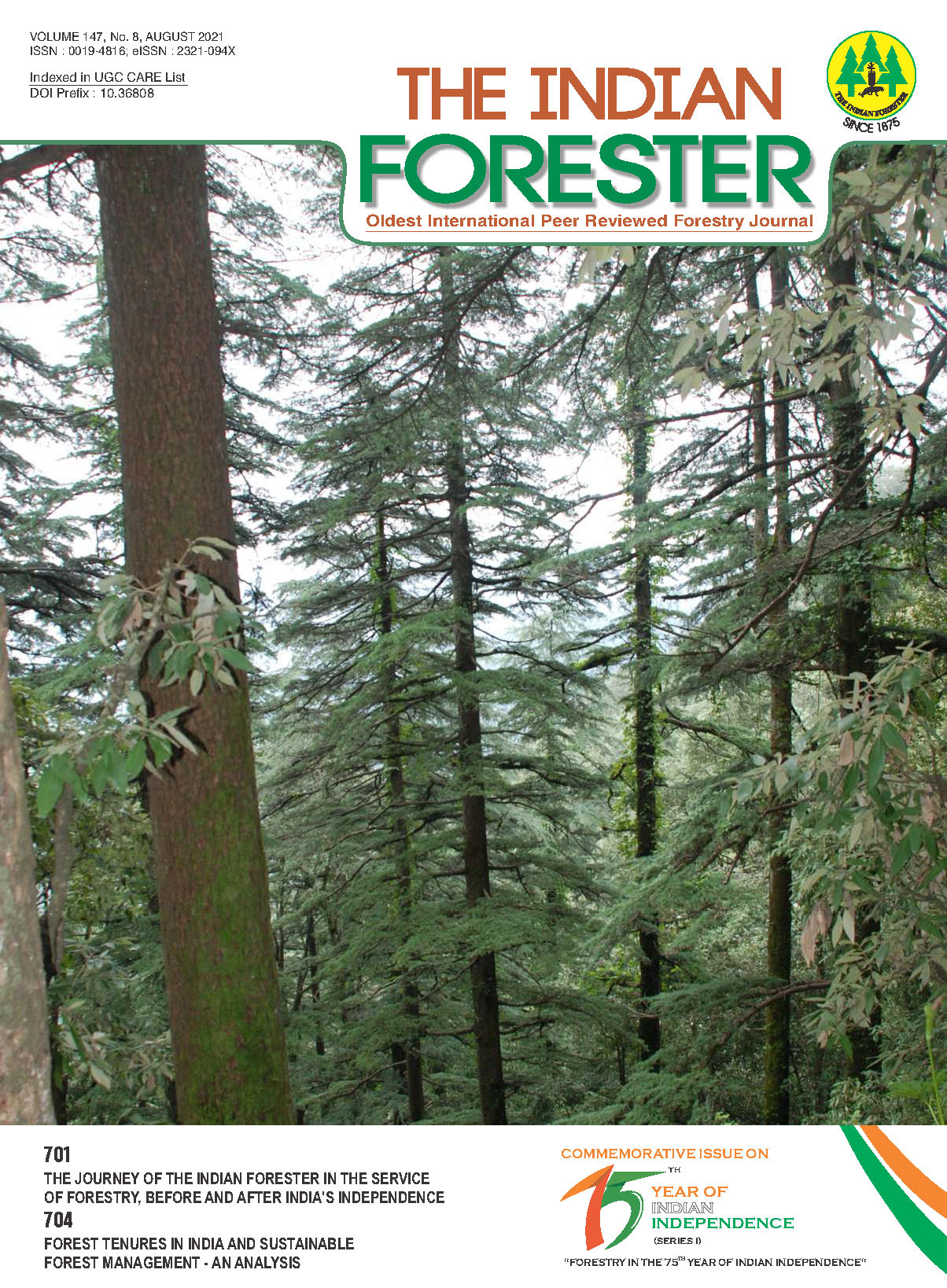Strategies in Forestry to Combat Global Climate Change
DOI:
https://doi.org/10.36808/if/2021/v147i8/165062Keywords:
Strategies, Natural Forests, Plantation, Seed, Flowering, Conservation.Abstract
Populations with little genetic variation are more vulnerable to the arrival of new pests or diseases, pollution, changes of climate and habitat destruction or other catastrophic events. Biological diversity is the best tool to counter environmental changes and combat climate change in uncertain future. Spatial isolation, fragmentation, increased in-breeding, low fruit set in disturbed natural forests necessitates more population sizes to generate enough variability through mutation and recombination's. Planting a diverse array of species and seed sources is a hedge in the face of global climate change. The best plantation strategy is to maintain diversity, breed for generalists, and deploy intimate mixtures of seed sources or progeny-tested families. Flowering time and seed maturation in plants could be altered in the scenario of climate change; so, should be understood and taken care off. In the era of climate change, conservation of forest genetic resources and their management is necessary to maintain required biodiversity to combat climate change. Seed banking is also a tool in combating the loss of global plant diversity.References
Angevine M.W. and Chabot B.F. (1979). Seed germination syndromes in higher plants. In Solbrig O.T., Jain S., Johnson G.B., Raven P.H. (Eds). Topics in plant population biology, New York, Columbia University Press Columbia, pp. 188-206.
Brack D. (2019). Forests and Climate Change. Forests and SDG, pp.1-56.
Campbell R.K. (1975). Adaptational requirements of planting stock. In: Globally Forestry and the Western Role. Proceedings, Western ForestryConservation Association, Portland, pp.103-107.
Cornett R.T. (2009). Seed Dispersal Distances and Plant Migration Potential in Tropical East Asia. Biotropica, 41(5): 592–598 2009.
Davis M.B. and Shaw R.G. (2001). Range shifts and adaptive responses to quaternary climate change. Science, 292: 673679.
Ellison D. (2018). Forest and Water. UNFF, pp.1-45.
Ellison D. Cindy E. Morris, Bruno Locatelli, Douglas Sheil, Jane Cohen, Daniel Murdiyarso, Victoria Gutierrez, Meine van Noordwijk, Irena F. Creed, Jan Pokorny, David Gaveau, Dominick V. Spracklen, Aida Bargués Tobella, UlrikIlstedt, Adriaan J. Teuling, Solomon Gebreyohannis Gebrehiwot,, David C. Sands, Bart Muys, Bruno Verbist, Elaine Springgay, Yulia Sugandi, Caroline A. Sullivan. (2017). Trees, forests and water: Cool insights for a hot world. Global Environmental Change, 43: 51-61.
Federici S., Lee D. and Herold M. (2017). Forest Mitigation: A permanent contribution to the Paris Agreement? Technical Report.
Franks S.J. and Hoffmann A.A. (2014). Genetics of Climate Change Adaptation. Annual Review of Genetics, 46: 185-208.
Garwood N.C. (1982). Seasonal rhythm of seed germination in a semi-deciduous tropical forest. In Leigh e.g., Rand A.S., Windsor D.M. (Eds). The ecology of a tropical forest: seasonal rhythms and long- term changes. Washington DC, Smithsonian Institution Press, pp. 173-185.
Garwood N.C. (1983). Seed germination in a seasonal tropical forest in Panama: A community study. Ecological Monographs, 53: 159-181.
Hamrick J.L., Linhart Y.B. and Mitton J.B. (1979). Relationships between life history characteristics and electrophoretically detectable genetic variation in plants. Annual Review of Ecology and Systematics, 10: 173-200.
Harrington J.B. (1987). Climatic changes: a review of causes. Canadian Journal of Forest Research, 17: 1313-1339.
Hopkins A.D. (1938). Bioclimatic: a science of life and climate relations. USDA Miscellaneous Publication No. 280. Washington, DC, pp. 168.
IPCC. (2007). Climate change 2007: the physical science basis. Contribution of Working Group I to the Fourth Assessment Report of the Intergovernmental Panel on Climate Change, Cambridge, UK.
Josline J.D., Wolfe M.H. and Garten C.T. (1997). Effect of soil warming on organic matter decomposition and soil nitrogen cycling in a high elevation Red Spruce Stand. In Mickler R.A. and Eox S. (Eds)The productivity and sustainability of South Forest Ecosystems in a changing environment. SpringerVerlag, New York.
Kitzmiller J.H. (1976). Tree improvement master plan for the California Region. U.S. Forest Services, San Francisco, California, pp.123.
Ledig F.T. and Kitzmiller J.H. (1992). Genetic strategies for reforestation in face of global climate change. Forest Ecology and Management, 50: 153-169.
Liang L. (2016). Beyond the Bioclimatic Law: Geographic adaptation patterns of temperate plant phenology.Progress in Physical Geography, SAGE. I-24.
Locatelli B. (2016). Ecosystem Services and Climate Change. In: PotschinM., Haines-YoungR., Fish R. and Turner R.K. (Eds) Handbook of Ecosystem Services. Routledge, London and New York, pp 481-490.
Makarieva A. and Gorshkov V. (2010). The biotic Pump: Condensation, atmospheric dynamics and climate. International Journal of Water, 5(4): 365-385.
Pan Y. (2011). A large and persistent carbon sink in the world's forest. Science, 333: 988-993.
Parmesan G. and Yohe G. (2003). Aglobally coherent fingerprint of climate change impacts across natural systems. Nature, 421: 37-42.
Parry M.L. (2007). Technical Summary. Climate Change 2007: Impacts, Adaptation and Vulnerability. Contribution of Working Group II to the Fourth Assessment Report of the Intergovernmental Panel on Climate Change. Cambridge University Press, UK.
Primack R.B. (1985). Patterns of flowering phenology in communities, populations, indivisuals and single flowers. In White J. (Ed.) Population Structure of Vegetation, Dordrecht, the Netherlands, Springer, pp. 571-593.
Tewari V.P., Verma R.K. and Gadow K.D. (2017).Climate change effects in the Western Himalayan ecosystems of India: evidence and strategies. Forest Ecosystems 4:13 Thapliyal R.C. and Phartyal S.S. (2005). Dispersal and germination syndromes of tree seeds in a monsoonal forest in northern India. Seed Science Research, 15: 29-42.
Troup R.S. (1921). Silviculture of Indian Trees. Oxford, Clarendon Press.
Urban M.C. (2015). Climate change. Accelerating extinction risk from climate change. Science, 348: 571-573.
Downloads
Downloads
Published
How to Cite
Issue
Section
License
Unless otherwise stated, copyright or similar rights in all materials presented on the site, including graphical images, are owned by Indian Forester.





